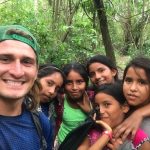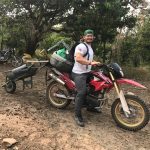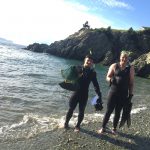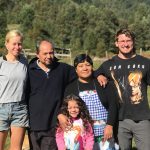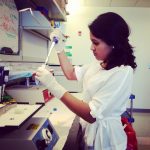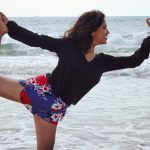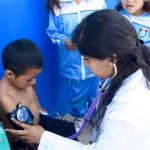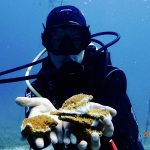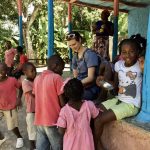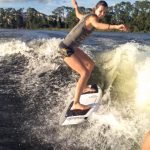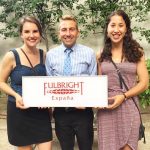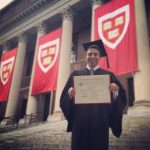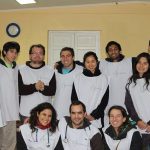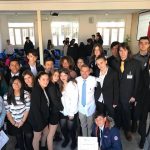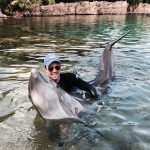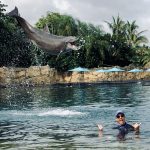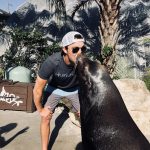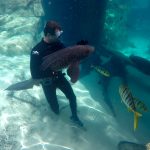- College of Medicine
The College of Medicine’s M.D. program recently welcomed the Class of 2022, the tenth since the charter class enrolled in 2009. Students were selected from a pool of 5,265 applicants – the highest yet – based on their academic excellence and passion for medicine.
Among them are a student who worked with a leprosy colony, another who cared for refugee children in Ukraine, a student who spent her life working to restore coral reefs, one who did independent research on cocaine addiction at the NIH, and a preemie who has devoted her life to help saving babies. Meet a few members of the class.
Hagen Mancuso
Globe-trekking humanitarian makes med school his next destination.

Hagen Mancuso has spent the last two years doing humanitarian projects in more than 15 countries across four continents.
He’s helped with hurricane relief efforts in Puerto Rico, taught English in the Ibera marshlands of Argentina and sustained forests in Chile and built dry composting latrines in Bolivia. He helped build a school in Ukraine and won second place in a cross country skiing marathon in Canada.
“I wanted to find out of medicine was really for me, and what better to do it than to work with those who are the most in need?” he said. “And spending time teaching children and working in underprivileged areas, helped me to witness my compassionate approach to service and realize how well suited I am to pursue medicine.
Mancuso took two years off before coming to medical school, and connected with WorkAway, an online community that provides opportunities for volunteering, work and cultural exchange. His first trip was to Newfoundland, Canada where he stayed with a family and helped care for their son, Sebastian, who had several mental health issues included autism and schizophrenia.
“Working with Sebastian was a truly life-changing experience and provided me with an opportunity to learn about medicine in a very hands-on setting.”
From there, Mancuso was hooked on the cultural exchange experience and the opportunity to make an impact on global health, and so continued his travels.
“Helping with the Ukrainian refugee children was a quite unique experience,” he said. “These were kids that had come from the east of the country where there was and continues to be a conflict with Russia. While they spoke no English, I was able to use the very basic Russian I knew to gain their trust and help them to see that there are people who care and want to help them succeed.”
In the jungles of Bolivia, where he spent 14 hours a day building latrines for impoverished families. He lived on yuca, a root vegetable, and charkey (dried meat). He learned how to wash clothes in a river that was only six inches deep. The village where he worked had no running water or electricity. Concrete for the latrines was mixed by hand.
“This was by far the hardest thing I have ever done in my life by one of the most rewarding,” he shared. “My time in Bolivia will help me as I go on to become a doctor in that no matter how hard things get, they will never be as tough as the people in this small community have it every day.”
Annalisa Sega
Committed to saving newborns.

Annalisa Sega entered the world 10 weeks earlier than her due date due to complications from her mother’s preeclampsia. Though she had a rocky first months of life, today Sega, 22, is devoting her life to saving premature babies.
She is a national spokesperson for the March of Dimes, which is dedicated to ending prematurity, birth defects and infant mortality. During her 11 years as a volunteer with the organization, she has testified in front of the U.S. House of Representatives, conducted research on premature babies and raised $22,000 for the organization. For her efforts, she received the March of Dimes’ National Volunteer of the Year Award in 2011 and a Spirit of Giving humanitarian award in in 2010.
Growing up, Sega always knew she wanted to pursue a career in medicine because of her own medical history and love of science, and this dream was cemented in her mind when she met obstetricians and families of preemies through her volunteer work.
“It was meeting these amazing people, volunteering at hospitals and in clinics, and knowing firsthand what it was like to be part of a family that suffered from a high-risk pregnancy, that I decided to pursue maternal fetal medicine,” she said.
“I want to help other mothers and babies get the care they deserve. Every child deserves a healthy start, and as a maternal fetal medicine specialist, I can help to guarantee that.”
After completing a bachelor’s in biology at Loyola University, Sega completed an American Heart Association Summer Research Fellowship at Yale University. Her topic: intracranial hemorrhage, a brain bleed many preterm infants suffer. That opportunity led to her becoming a research assistant investigating birth defects with unidentified genetic causes. She also shadowed pediatricians at the Yale New Haven Hospital.
When she is not advocating for premature babies or doing research on birth defects, Sega makes time for her other passion – dancing.
“I have been dancing since I was 2 years old,” she said. “It started as a type of physical and social therapy for my prematurity and its developmental complications, but quickly grew into my favorite hobby.”
She dances competitively and was a member of Shockwave Dancers, part of the Tulane University Marching Band.
“Dance has taught me essential skills: managing time, following directions, respecting authority and learning from mistakes,” she said. “It has taught me resiliency, respect and that practice can make perfect. These are skills that are very important in medical school, and I will take the lessons I learned in dance with me throughout my academic career.”
Yasaswi Vengalasetti
Healing with understanding

Yasaswi Vengalasetti was 5 when he grabbed a crayon and drew a picture of himself wearing a stethoscope and a white coat. As he grew, the idea of medicine as a career become clearer in his mind.
“I would volunteer on the weekends in the hospital and working with patients I quickly realized that there is no better feeling than helping people get back on their own feet,” he said.
“Every activity I took part in throughout college and graduate school reaffirmed my belief that medicine was the right track for me.”
One of those activities included caring for patients at leprosy colony in India, his native country. He was a freshman at the University of California-Davis and joined Project RISHI, an organization dedicated to sustainable development of rural Indian communities. One of the villages the team worked on was Anandwan, a rehabilitation colony for leprosy patients who had been shunned from their homes and community.
As he wrapped the wounds of afflicted patients, he heard their stories of isolation. “Interacting with those patients made me realize, in healthcare we often can fail to see beyond the physical manifestations of the disease,” he said.
“As a future doctor, my time in the village of Anandwan continually reminds me that in order to help patients improve I need to think beyond what is lurking in their body but what else can be affecting mind, spirit and home.
Outside of humanitarian work, Vengalasetti is also actively involved in the performing arts. He is trained in Indian Carnatic vocal music and has won several national competitions. He is also a competitive Bollywood dancer with training in hip-hop, salsa and break dance.
“By dancing with a team, I needed to learn to sync to the group’s rhythm, learn from other teammates, and work as a unit,” he said.
“Healthcare is much the same way. In order to deliver care, we need to work as a team. As medical students, we are all invested in our patients’ care and are more than happy to support one another if our patients are better for it.”
Pooja Selvam
Classical Indian dance leads to a love of medicine

Pooja Selvam has danced as long as she can remember and says performing the classical dances of India helps her “final mental clarity and establish a strong identify with my cultural roots.”
In fact, dance ended up drawing her to medicine.
As a winner in dancing and singing championships in her hometown of Washington D.C., Selvam was asked to perform at a public health summit organized by the American Tamil Medical Association. After her performance, she stayed at the event to shadow physicians doing free check-ups to attendees, serving as their medical scribe.
She was impressed by their compassion. “I remain inspired by the physicians’ ability to understand a patient beyond his or her symptoms, and to draw upon their knowledge to diagnose and propose treatments to help patients overcome their health challenges,” she said.
In 2012, she started an American Red Cross chapter at the University of Maryland, her alma mater, and quickly became aware of the health issues affecting the Baltimore area.
“As a group, we volunteered regularly at soup kitchens, addiction clinics and homeless shelters, where I witnessed the devastating consequences of addiction and effects of poverty that plague the inner cities of my hometown,” she said. That realization led her to do undergraduate research with the NIH’s National Institute on Drug Abuse to on how cocaine addiction affects the brain.
“By exploring the biological connection to addiction, I see the potential to discover new therapeutic targets,” she said, “and provide relief to not just those who suffer the physiological damage of addiction, but also to communities affected by drug violence.”
After a range of physician shadowing experiences during her undergraduate years – a medical mission trip to Peru, working in the cardiac ICU at Johns Hopkins Hospital – Selvam feels ready for her next challenge: medical school.
“I cannot contain my excitement,” she said. “To me, the white coat symbolizes my commitment to a life of serving others: my patients, my peers and my community.”
Julia Nedimyer
From coral reef restoration to medical school

Julia Nedimyer grew up in the Florida Keys idolizing her father, Ken, the founder of Coral Restoration Foundation, one of the largest reef restoration projects in the world. “He has always encouraged me to live a life of purpose and meaning, one that extends beyond simply my own well-being,” she said.
Nedimyer has been a team leader at the foundation since she was 12, helping to build coral nurseries throughout the Caribbean and South America. As a UCF health sciences major, she conducted research identifying compounds in coral that could could fight cancer.
Interested in medicine even before her undergraduate years, Nedimyer participated in a month-long medical practicum at Klinikum Hildesheim in Germany where she shadowed surgeons in the operating room, took patient histories and assisted doctors and nurses.
There she met an elderly man who was anxious about his upcoming double hip replacement. The patient had a reputation for being difficult, buy Nedimyer gained his trust and he insisted she accompany him to his surgery for good luck. She stayed in the operating room and held his leg as surgeons repaired it. After surgery, when he was able to walk for the first time in eight weeks, the patient cried as he thanked his “lucky little star.”
“This was the moment I realized that I wanted to become a physician,” she said. “The ability to be a meaningful pillar of support for someone in a time filled with uncertainty and distress made something clear – I want to be the one to actively make a difference in my patients’ lives,” she said.
Outside of medicine, Nedimyer loves the outdoors. She enjoys wakeboarding, flow boarding, playing soccer, riding horses and rock climbing. “I’m a bit of an adrenaline junkie,” she admits.
She said she chose the UCF College of Medicine because it’s not afraid to challenge convention – something she relishes.
“What they have already accomplished at such a young medical school is inspirational and motivating,” she said, “And I am excited to be a part of that future.”
Matthew Abrams
Fulbright scholar wants to go into psychiatry to give a voice to
those suffering stigma

Matthew Abrams’s mother died from alcoholism when he was 11 and he grew up in City Heights, an underserved section of San Diego. He’s seen addiction and health disparities first-hand and that’s why he wants to go into medicine.
“I believe that everyone deserves to have an advocate, even the most vulnerable in our populations whose families sometimes have given up on them,” he said. “I plan to go into psychiatry after I graduate in order to help give a voice to those suffering from stigma and shed light on the biological underpinnings of mental illness.”
“I want to continue to improve treatments for those suffering from illness, empower others to make informed health decisions, and ultimately prevent families from losing loved ones like I did.”
Abrams attended Harvard, where he studied cognitive neuroscience to understand the intricacies of the human mind. He conducted research on how empathy affects the brain and the genetic risk factors leading to alcohol and drug abuse.
He was named a Fulbright scholar and in 2015, traveled to an underserved area of Madrid where he taught students in a bilingual program scientific concepts and global health issues. He also worked at a clinical psychology lab at Complutense University, publishing research on the role of the economic recession on mental health and depression levels in Spain.
He spent three years overseas, in what he called “one of the most transformative experiences” of his life. “It strengthened my passion for advocating for Spanish-speaking communities and immigrant health,” he said.
Abrams chose UCF in part due to its strong commitment to correcting health disparities at home and abroad, and is looking forward to helping with the College of Medicine’s programs to help the underserved in Peru and farmworkers in Apopka.
He’s also impressed by the ready access to nearby hospitals, and by the strong culture of health and fitness around Medical City. In his spare time, he’s an avid weight lifter, runner and hiker.
“There are so many lakes to run around and outdoor sports to partake in,” he said. “I also loved how UCF encourages students to not only exercise regularly, but also find time for self-care, meditation and whatever it takes to promote positive mental health.”
Michael Thompson
From aquatic animal trainer to physician

Michael Thompson’s passion has always been life under the sea – he spent the last six years training animals at Sea World and providing medical care to 180 different species, from sharks to dolphins.
He’s done blood draws on a shark and performed ultrasounds on a pregnant dolphin. And Thompson says his work with sea animals developed his passion for human medicine.
Through Sea World, he became involved with One Health Initiative, which promotes collaboration between doctors, veterinarians and environmental scientists.
One Health works to improve the health of all species by recognizing that human and animal health and the ecosystem are “inextricably linked.” For example, the Centers for Disease Control says more than half of all human infections – such as rabies and West Nile virus — originate in animals.
“The idea of synergy between animal, human and environmental health really resonated with me,” Marshall said. “I recognized that I could use my skills and knowledge acquired during my time spent with animals and apply it in human medicine.”
Thompson received his bachelor’s degree from the UCF College of Medicine’s Burnett School of Biomedical Sciences and during his undergraduate training shadowed neurologists and neurosurgeons – the medical specialty that interests him most.
“I love the puzzle of preventing, diagnosing and treating diseases,” he said. “The idea of embracing difficult challenges and helping another living being spoke to my core values.”
